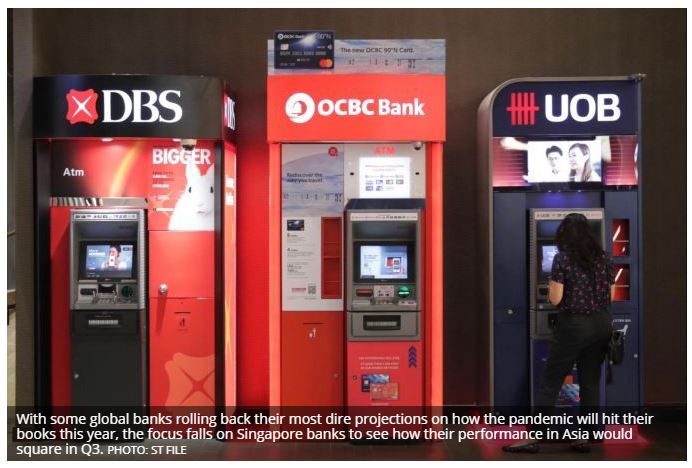Singapore banks’ Q3 results in focus over Malaysia debt holiday impact
WITH some global banks rolling back their most dire projections on how the pandemic will hit their books this year, the focus falls on Singapore banks to see how their performance in Asia would square in Q3.
As Malaysia’s loan moratoriums have been tightened from automatic qualification to targeted debt holidays for applicable borrowers since this month, analysts are looking for the impact of the payment delay on two of the trio.
Malaysia is a key market for OCBC and UOB, making up about 14 per cent of OCBC’s core pre-tax profit and about 11 per cent of UOB’s overall pre-tax profits in 2019. DBS has a negligible presence in Malaysia.
Malaysian loans – mostly secured – account for half of OCBC’s loans under moratorium and 60 per cent for UOB.
CGS-CIMB Securities banking analyst Andrea Choong expects repayment trends of OCBC’s and UOB’s Malaysia books to hold up, given the banks’ higher-tiered client segment there. UOB could be a larger beneficiary of improved asset quality indicators given its larger share of Malaysian loans under moratorium compared with OCBC.
New non-performing loans (NPLs) could also be smaller than what was previously guided, Ms Choong added. UOB management previously disclosed that 16 per cent of its loan book is under moratorium, out of which about 10 per cent of loans under moratorium could become NPLs.
The performance there would “impact the assessment of the eventual moratorium expiry in Singapore and their gauge of NPLs”, she said.
“This would give the market a better picture of how realistic or conservative the banks’ guidance for impairments is, to judge whether the worst is over.”
Likewise, Krishna Guha, equity analyst at Jefferies, said if collections are healthy once the moratorium has lapsed in Malaysia, the proportion of loans under moratorium for UOB should come down.
Even so, analysts said that credit costs will likely stay elevated across the three banks as management remains prudent, with the economy still in the doldrums.
But Tay Wee Kuang, analyst at Phillip Securities Research, said based on previous provisions, there may not be cause for any of the banks to increase provisions at a faster rate, unless there is an unforeseen uptick in specific provisions arising from big accounts.
DBS analyst Lim Rui Wen also thinks that major new NPLs are unlikely due to ongoing moratorium and relief measures in place. Most of oil-and-gas-related NPLs linked to Hin Leong have also been largely provided for.
With the latest extensions of support measures for individuals and SMEs facing cashflow difficulties, specific provisions may only pick up in the first half of 2021, she said.
Among the three banks, she expects UOB to see the highest provisions as the bank lags the rest in terms of actual provisions, even though UOB has set aside S$260 million in regulatory loan loss reserve during the first quarter for general provisions.
Similarly, Ms Choong expects DBS and OCBC to see larger quarter-on-quarter credit cost improvements, given their more “aggressive” front-loading of provisions in the first half of the year. Those of UOB will likely remain elevated, she said.
Phillip’s Mr Tay noted that the rolling back of US banks’ most severe prognosis of the Covid-19 situation coincided with a positive recovery in the economic data released over the past few months.
“However, the Singapore economy remains subdued as the government evaluates reopening plans,” he noted, adding that local banks will continue to pursue their targeted credit cost guidance. This may change only if the economy and the most deeply impacted sectors recover close to pre-Covid levels, he said.
Shares of the three local banks have fallen 21-28 per cent since the start of the year, with UOB losing the most ground in percentage terms. But checks by BT also showed there has been a slight lift in optimism, judging by the marginally higher number of “buy” calls for DBS and OCBC at this point.
Analysts expect net interest margin (NIM) pressures to remain for the three banks as loans continue to price downwards, but are on the lookout for signs of stabilisation this quarter.
Jefferies’ Mr Guha is expecting DBS to see the most compression in margins quarter-on-quarter, followed by OCBC. NIM for UOB, on the other hand, could reverse after falling sharply in the second quarter, he said. This improvement comes as the bank let go of more expensive deposits during the quarter.
Revenue will likely be supported by fee income. Ms Lim believes that fee income across all banks will show sequentially better performance, driven by strong rebound in wealth management, bancassurance, and cards.
However, trading income may be weaker quarter-on-quarter, due to the second quarter’s high base effect, she added. This could result in mixed overall non-interest income.
UOB will kick off the third quarter results season on Nov 4, followed by DBS and OCBC on Nov 5. Shares of DBS closed at S$20.35 on Friday, down 21 Singapore cents; OCBC closed at S$8.42, down four Singapore cents; UOB closed at S$18.99, down 12 Singapore cents.
Source: https://www.businesstimes.com.sg/companies-markets/singapore-banks-q3-results-in-focus-over-malaysia-debt-holiday-impact


 English
English




